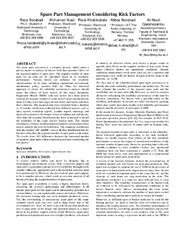Spare Part Management Considering Risk Factors
Permanent lenke
https://hdl.handle.net/10037/24863Dato
2022-01-01Type
Journal articleTidsskriftartikkel
Peer reviewed
Sammendrag
The spare parts provision is a complex process, which needs a precise model to analyze all factors with their possible effects on the required number of spare parts. The required number of spare parts for an item can be calculated based on its reliability performance. Various factors can influence the reliability characteristics of an item, including operational environment, maintenance policy, operator skill, etc. Thus, the statistical approach of choice for reliability performance analysis should assess the effects of these factors. In this study, Reliability Regression Models (RRM) with risk factors have been used to estimate the required number of crane shovels in the Jajarm bauxite mine. For this, at the first stage, all risk factors and failure data have been collected. The required data were extracted from a database of 15 months, which were collected from different sources, such as daily reports, workshop reports, weather reports, meetings, and direct observations in the format of time to failures and risk factors. After that, the potential distribution has been nominated to model the reliability of the crane shovels bucket teeth. The Akaike information criterion and Bayesian information criterion have been used to identify the best fit distribution. The candidate distribution with the smallest AIC and BIC value is the best distribution that fits the data. After that, the required number of spare parts is calculated. The results show 18% differences between the forecasted number of required spare parts when considering and non-considering the risk factors.
Forlag
SpringerSitering
Barabadi, Ataei M, Khalokakaie R, Barabadi A, Nouri a. Spare Part Management Considering Risk Factors. Lecture Notes in Mechanical Engineering. 2022:24-39Metadata
Vis full innførselSamlinger
Copyright 2022 The Author(s)


 English
English norsk
norsk